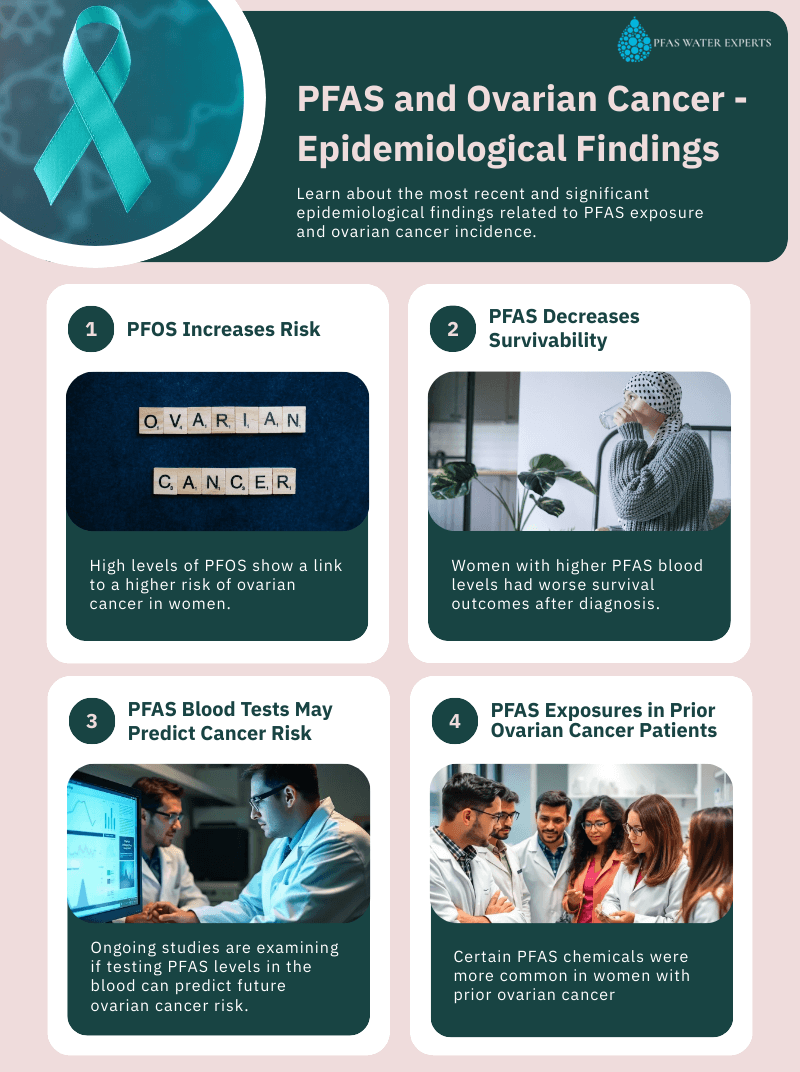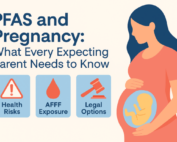Introduction
Ovarian cancer ranks among the most deadly cancers affecting women, largely because it is often diagnosed late. As research into environmental causes of cancer advances, there is increasing interest in whether exposure to PFAS (per- and polyfluoroalkyl substances) contributes to ovarian cancer risk. PFAS are used in industrial and consumer products, persist in human tissues, and are already linked to hormonal disruption and immune system effects.
This article reviews what scientific studies say so far, including newer findings (2023-2025), considers special risk among military personnel, and addresses related concerns about talc exposure and how it may compound the risk of ovarian cancer.
Epidemiological Evidence Linking PFAS to Ovarian Cancer
PFOS and Ovarian Cancer Risk – Jones, R. R. et al. (2025)
Significant Finding: High blood levels of PFOS and related chemicals were linked to an increased risk of ovarian cancer in women.
PFAS and Ovarian Cancer Survival – Xing et al. (2025)
Significant Finding: Women with higher PFAS blood levels had worse survival outcomes after ovarian cancer diagnosis.
PLCO Cancer Screening Trial (Ongoing) – PFAS Measured Before Diagnosis
Significance: The PLCO trial is the first major study to test whether PFAS levels in blood years before diagnosis can predict ovarian cancer risk.
Exploratory Chemical Exposure Study (2023) – Prior Ovarian Cancer Diagnoses
Significant Finding: Some PFAS chemicals were more common in women with prior ovarian cancer, particularly among White women.
Biological Mechanisms: How PFAS Might Cause or Worsen Ovarian Cancer
Understanding how PFAS could influence ovarian biology helps clarify why the epidemiologic signals may make sense:
- Hormonal Disruption: Ovarian tissue is highly sensitive to hormone signals. PFAS can mimic or interfere with estrogen or progesterone, potentially promoting cell growth of ovarian tissue in abnormal ways.
- Oxidative Stress and DNA Damage: PFAS exposure can increase reactive oxygen species, which damage DNA. This could lead to mutations in ovarian cells.
- Altered Ovarian Function: Lab studies show PFAS exposure can disrupt ovarian hormone production (e.g. estradiol), follicle maturation, and may accelerate depletion of reserve follicles, which can lead to inflammation and cellular dysregulation.
- Immune System Effects: PFAS may impair immune surveillance (i.e. how well the body detects and eliminates abnormal cells) allowing tumors to grow unchecked.
- Subtype Differences: Some ovarian cancers are more aggressive (e.g. high-grade serous ovarian cancer, which makes up a large portion of ovarian cancer deaths) and may react differently to PFAS exposure. The Xing et al. study suggests survival in certain subtypes declines more steeply with higher PFAS burdens.
Talcum Powder and Ovarian Cancer: A Related Concern
Complicating matters is that other genetic and environmental factors may also play a role in ovarian cancer development.
For example, while PFAS is newer in research, talcum powder has been studied for many years as a significant risk factor for ovarian cancer due to the fact that many talc products until ~2020 contained asbestos – the same substance that is tied to mesothelioma.
The Sister Study (2024)
One of the most significant studies connecting talc and ovarian cancer is the Sister Study which was completed and released in 2024. This study tracked genital talc use in ~50,884 women throughout young adulthood and compared ovarian cancer rates.
The study found that women who regularly applied talc to the genital area had higher ovarian cancer risks (hazard ratios ranging from ~1.17 to 3.34, depending on frequency/duration).
Other Data on Talc and Ovarian Cancer
Additional meta-analyses (e.g. Penninkilampi et al. (2018)) reported about a 30-35% increase in ovarian cancer risk in women who used talc in the genital area compared to those who didn’t.
The American Cancer Society and IARC both regard talc (especially when contaminated with asbestos or used genitally) as a possible/probable human carcinogen.
It is important to note that talc and PFAS are different exposures but may overlap in certain personal care products or environmental contamination. Together, they paint a broader picture of hidden environmental carcinogens affecting women’s reproductive health. Understanding both helps with comprehensively assessing risk if someone has used talc and also had PFAS exposure.
Female Military Personnel and Dual Exposure Risks
Female service members face heightened risks when it comes to toxic exposures that may cause ovarian cancer.
- PFAS in AFFF and base water supplies
On military installations, aqueous film-forming foam (AFFF) has been heavily used for firefighting training and emergencies. These foams are a major source of PFAS contamination in base drinking water and soil. Service members stationed at these sites—whether they directly handled AFFF or simply lived and worked on base—may have accumulated higher levels of PFAS in their blood compared to the general population. - Frequent talcum powder use in the field
In addition to PFAS exposure, many women in the military relied on talcum powder during field training and deployments. Talc was often used to prevent chafing and keep skin dry under extreme physical and environmental conditions. Decades of research have raised concerns about the link between genital talc use and ovarian cancer, with lawsuits filed against manufacturers like Johnson & Johnson highlighting the potential dangers. - Combined risk factors
What makes this situation especially concerning is the potential dual exposure: women in the military could have faced both systemic PFAS exposure through contaminated water and direct talc exposure to reproductive areas. While research is still developing, scientists recognize that multiple carcinogenic exposures can act together to increase overall cancer risk or severity. This means female veterans with ovarian cancer may have a stronger case when documenting exposures in both categories for health monitoring and legal claims.
👉 Why it matters now: With ovarian cancer already being one of the harder conditions to detect early, the overlapping exposures experienced by female service members deserve closer attention from both the medical community and the legal system. Veterans’ advocacy groups are now pressing for expanded toxic exposure screenings that account for both PFAS and talc histories.
Ovarian Cancer Lawsuits
PFAS Lawsuits (AFFF MDL 2873)
The main PFAS lawsuit is the AFFF multidistrict litigation (MDL 2873) in South Carolina. Right now, kidney, testicular, thyroid and liver cancers, ulcerative colitis, and a few other conditions are officially included. Ovarian cancer is not yet an accepted condition, but new scientific evidence (like Jones 2025) is making the case stronger.
Talcum Powder Lawsuits
Thousands of women have already filed lawsuits against talc product manufacturers (notably Johnson & Johnson), claiming genital talc use contributed to ovarian cancer. Some cases have already resulted in large settlements to injured individuals, while others were dismissed or overturned, which demonstrates the legal complexity of proving a claim.
Dual Exposures
If you were exposed to both talc and PFAS, especially female military veterans, it’s important to document both. The legal landscape may evolve to cover dual exposures, strengthening personal injury claims and potentially increasing claim settlement amounts for dual exposure victims.
Conclusion
The scientific evidence linking PFAS to ovarian cancer is still emerging but increasingly credible. New studies published in 2025 provide stronger signals, especially for PFOS and certain PFAS precursors.
Talc remains a parallel risk factor that has been more extensively litigated. For military personnel and others with known PFAS exposure, there may be grounds for legal claims—but timing, documentation, and exposure history will be critical.
If you or someone you know has ovarian cancer, consider filing a claim now to preserve your possible legal rights. Early registration, along with good medical and exposure records, gives the best chance for a successful injury claim settlement.







